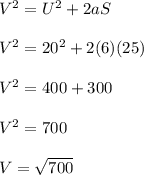
Physics, 18.11.2019 12:31 Coolcatfurzy
An object initially traveling at 20 meters per second south accelerates uniformly at 6.0 meters per second squared and is displaced 25 m calculate the final velocity of the object

Answers: 1


Another question on Physics

Physics, 21.06.2019 18:10
Scientists use laser range-finding to measure the distance to the moon with great accuracy. a brief laser pulse is fired at the moon, then the time interval is measured until the "echo" is seen by a telescope. a laser beam spreads out as it travels because it diffracts through a circular exit as it leaves the laser. in order for the reflected light to be bright enough to detect, the laser spot on the moon must be no more than 1.0 km in diameter. staying within this diameter is accomplished by using a special large-diameter laser. part a if λ = 540nm , what is the minimum diameter of the circular opening from which the laser beam emerges? the earth-moon distance is 384,000 km. express your answer to two significant figures and include the appropriate units.
Answers: 1

Physics, 21.06.2019 22:30
Follow these directions and answer the questions. 1. shine a pencil-thin beam of light on a mirror perpendicular to its surface. (if you don't have a laser light as suggested in the video, you can make a narrow beam from a flashlight by making a cone from black construction paper and taping it over the face of the flashlight.) how does the light reflect? how does the relationship of incident to reflected ray relate to the reflection of water waves moving perpendicular to a barrier? 2. shine a pencil-thin beam of light on a mirror standing on a sheet of paper on the table (or floor) so that you can mark the incident ray and reflected ray. (you can support the mirror from the back by taping it to a wooden block.) 3. mark a line on the paper representing the reflective surface. (the reflective surface of a mirror is usually the back edge.) 4. draw a dashed line perpendicular to the mirror surface at a point where the incident and reflected ray meet. this perpendicular is called a normal to the surface. 5. measure the angles between the rays and the normal. the angle of incidence is the angle formed by the incident ray and the normal to the surface. the angle formed by the reflected ray and normal is called the angle of reflection (r). what is the angle of incidence? what is the angle of reflection? 6. repeat for several different angles. (see report sheet for details.) what appears to be the relationship between the angle of incidence and angle of reflection? in science 1204, what was the relationship for these two angles made by the reflection of waves in a ripple tank? 7. roll a ball bearing so that it hits a fixed, hard surface (a metal plate) at several angles (including head-on). observe the way in which the ball bearing reflects. what generalization can you make about how a ball bearing reflects from a wall? have you proved that light can only behave like a wave?
Answers: 1

Physics, 22.06.2019 15:30
At 20∘c, the hole in an aluminum ring is 2.800 cm in diameter. you need to slip this ring over a steel shaft that has a room-temperature diameter of 2.804 cm . 1. to what common temperature should the ring and the shaft be heated so that the ring will just fit onto the shaft? coefficients of linear thermal expansion of steel and aluminum are 12×10−6 k−1 and23×10−6 k−1 respectively.
Answers: 1

Physics, 22.06.2019 16:00
In which of the following is positive work done by a person on a suitcase
Answers: 1
You know the right answer?
An object initially traveling at 20 meters per second south accelerates uniformly at 6.0 meters per...
Questions

Spanish, 31.07.2019 04:00



Social Studies, 31.07.2019 04:00

Mathematics, 31.07.2019 04:00

Mathematics, 31.07.2019 04:00


Biology, 31.07.2019 04:00





Mathematics, 31.07.2019 04:00

English, 31.07.2019 04:00




Mathematics, 31.07.2019 04:00


Mathematics, 31.07.2019 04:00

 Displacement = 25 meters.
Displacement = 25 meters.


